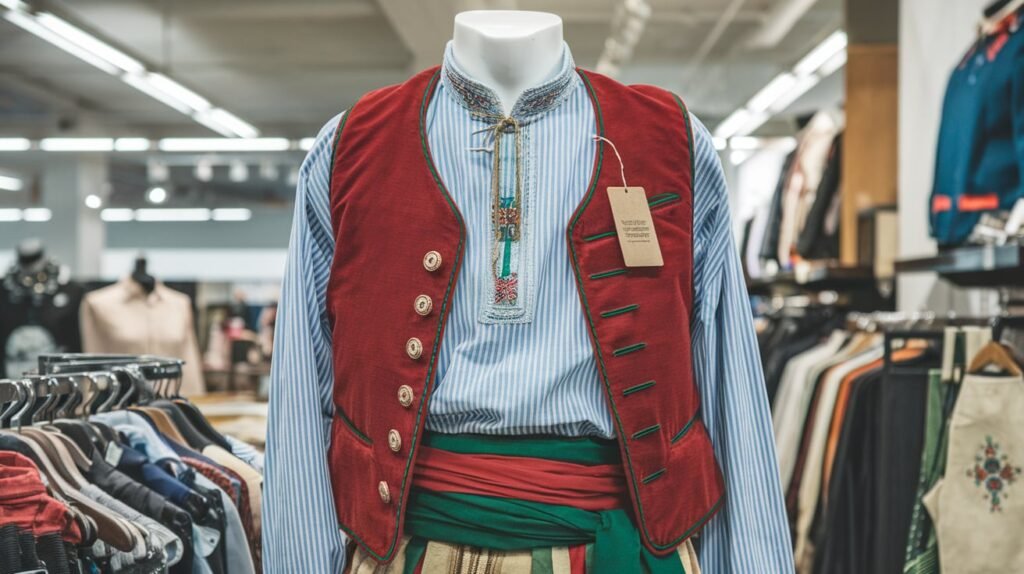
Introduction
Our love for traditional clothes only dates back to the rich cultural heritage and history of diverse communities in most parts of the world. Buying traditional clothing can be so rewarding, either when buying for special occasions, cultural events, or even embracing your roots. However, it can also be overwhelming without proper direction. This guide provides you with an easy, real-life, step-by-step approach to guide you in the world of traditional clothing to make informed and satisfying purchases.
Understanding Traditional Clothing
But before getting into shopping tips, let’s first ask what traditional clothing even entails. Traditional clothing is very diverse and it depends on the culture, fabric, design, as well as the meaning behind the wearers’ sport. From Indian sarees with intricate weaves to African Kente cloth with all sorts of bright colors, to elegant lines found in Japanese kimonos, and rich embroidery on the Mexican huipiles, traditional clothing is an embracing of diversity in culture and craftsmanship.
Researching Cultural Significance
You start by researching the cultural significance of the clothes you find that appeal to you. Knowing how these garments have been created, the history and symbolism behind the garments, will give you much more information on this clothing and help you make decisions closer to the authentic choices. Consider these:
- History and Origin: A history of how the traditional costume came into existence, how it has evolved, and its standing in culture.
- Symbolism: Colours, patterns, and designs that have meanings have been woven into the traditional attire. For example, certain colours mean prosperity and fertility, while others post a death notice.
- Craftsmanship: Learn in traditional skills used in manufacturing, and within these, weaving, dyeing, and embroidery.
Setting a Budget
Traditional clothing can range from very cheap to very expensive; the materials, craftsmanship, and brands all play their part in such variations. Having a budget in mind before going out to shop will also help limit your choices for consideration and make informed decisions while buying: Budgeting Tips
- Assess Your Needs: What is the purpose for your purchase? Do you need something to wear regularly, for special occasions, or perhaps it’s a collector’s piece? The amount that should be spent is determined based on this purpose.
- Research Prices: Find what average prices are for the specific type of traditional clothing you intend to purchase. With that, you set your budget.
- Quality First: Although tempting to choose lower-priced options, traditional clothing made with quality materials will last longer and will be authentic.
Finding Reputable Sellers
- First and foremost, in the case of traditional clothing, one of the most important considerations in shopping is accessibility to authentic sellers who sell quality pieces. In this area, it is possible to look for:
- Local Artisans and Craftsmen: Buy from local artisans, ensuring a contribution to the local community in return for authentic clothes. Visit the local market, craft fairs, and cultural festivals to get artisans selling traditional attire.
- Specialty Stores: We look for specialty stores specialising in traditional clothing. Although selections will be fewer, we feel that specialty stores have a more refined portfolio, and the staff should give you some critical understanding of the cultural significance and craftsmanship.
- Online Retailers: Many online retailers sell the traditional garments from various cultures. While online shopping, read reviews given by customers, check return policies, and be sure the product is genuine.
- Cultural Organizations and Fair Trade Shops: These organisations and shops are another form of official organisations that have teamed up with artisans for the sake of doing promotion and sales of traditional attires. Buying from such groups ensures that you are buying ethically produced and fairly traded garments.
Understanding Fabric and Material
The choice of fabric and material is what ensures traditional clothing is comfortable, aesthetic, and long-lasting. Some of the most frequently used fabrics in traditional clothing and tips while selecting the best option include: Cotton: Breathable fabric known to be comfortable and hence widely used, especially in Indian kurtas, African dashikis, as well as Mexican blouses.
Silk Silk is full of luscious texture and eloquent drape. It is taken into account in the traditional garments like Indian sarees, Chinese cheongsams, and Thai silk wraps.
Wool Wool imparts warmth and strength. It, thus, forms an ideal material for various traditional attires, such as Scottish kilts, Tibetan chubas, and the oriental abayas.
Linen Linen is light in weight and breathy. It, thus, would form a good fit for such traditional garments like Greek chitons, Egyptian tunics, and Filipino barongs.
Synthetic Fabrics: In this aspect, although not traditional, polyester, rayon, and even others can easily be used because of economy and easy care at home. Still, they may often lack cultural authenticity.
You also need to consider climate, occasion, and comfort when making a choice for your fabric. You should also check if the clothes require special care to make them last long.
Paying Attention to Fit and Size
Traditionally, traditional clothing usually follows the old ways of sizing and fitting, which can sometimes not be the same as in modern days. However, getting the right fit is significant, especially in terms of comfort and aesthetic styling of most wearers. Here are some tips on the right size:
- Understand sizing charts: the traditional clothing may have variant size charts from other cultures, so pay attention to sizing conventions and measurements used for the garment.
- Try Before You Buy: If possible, try on clothing before you buy. It is very crucial where garment fit is concerned, especially tailored or fitted outfits.
- Changes: Be willing to change. Many traditional brides gowns can be altered into the perfect fit. Consider inquiring whether alteration services are available.
Considering Color and Design
Colour and design are the strongest aspects of traditional clothing; they possess cultural, as well as personal significance. The following shall be put into consideration when choosing traditional wear.
- Cultural Symbolism: Colours and designs should be considered imbued with cultural meaning; for example, red in one culture may represent good luck, while in another represents mournings.
- Personal Preference: Choose such colours and designs for a dress that would appeal to your personal taste and preference. Even while being sensibly sensitive to the cultural norms, it’s also true that one should be feeling confident and comfortable in attiring himself or herself.
- Versatility: Now, use designs and colours that can be easily paired with some other garments in your wardrobe. That increases the versatility and wearability factor.
Authenticity and Ethical Considerations
Authenticity and ethical considerations are paramount when shopping for traditional clothing. Here are some tips to ensure you make responsible choices:
- Verify Authenticity: Look for indicators of authenticity such as traditional techniques, genuine materials, and reputable sellers. Avoid mass-produced imitations that may lack cultural integrity.
- Support Fair Trade: Purchase from fair trade organisations and sellers who ensure fair wages and working conditions for artisans.
- Respect Cultural Sensitivity: Be respectful of the cultural significance of traditional clothing. Avoid cultural appropriation by understanding and honouring the meaning behind the garments.
Caring for Traditional Clothing
- Traditional clothing needs proper care and maintenance to be used fully and live as long as they can. Here are some general guides for taking care of different types of traditional clothing:.
- Learn to read care labels: Most garments have an instruction label with care instructions. Traditional clothing may require special care such as hand washing, dry cleaning, or special storage requirements.
- Handle with Care: Such delicate fabrics and intricate designs warrant gentle handling. Avoid any rough handling, pulling, or stretching that could damage the garment.
- Store appropriately: Second-hand clothing must be kept in a cool, dry place away from direct sunlight. Make use of padded hangers or fold garments neatly to prevent creasing and damage.
- Clean Up Promptly: Treat stains and spills immediately, preventing permanent damage. Use proper cleaning techniques and chemicals for the type of fabric and material.
Exploring Different Cultures
One of the most exciting aspects of shopping for traditional clothing is the opportunity to explore and appreciate different cultures. Here are some tips for broadening your cultural horizons through traditional attire:
- Attend Cultural Events: Participate in cultural festivals, exhibitions, and events that showcase traditional clothing. This allows you to experience the garments in their cultural context and learn from those who wear them.
- Visit Museums: Explore museums that feature traditional clothing and textiles. Museums often provide historical and cultural insights that enhance your understanding and appreciation.
- Connect with Communities: Engage with cultural communities and individuals who can share their knowledge and experiences. This can provide valuable insights and foster meaningful connections.
Conclusion
Shopping for traditional clothing is a journey that goes beyond the mere act of purchasing garments. It’s an opportunity to connect with cultural heritage, appreciate craftsmanship, and celebrate diversity. By following these tips, you can make informed and responsible choices, ensuring that your traditional attire is authentic, ethically sourced, and meaningful.
Remember, traditional clothing is more than just fashion; it’s a reflection of history, identity, and artistry. Embrace the richness of traditional attire and wear it with pride, honouring the cultures and stories that have shaped these beautiful garments.
Happy shopping!
